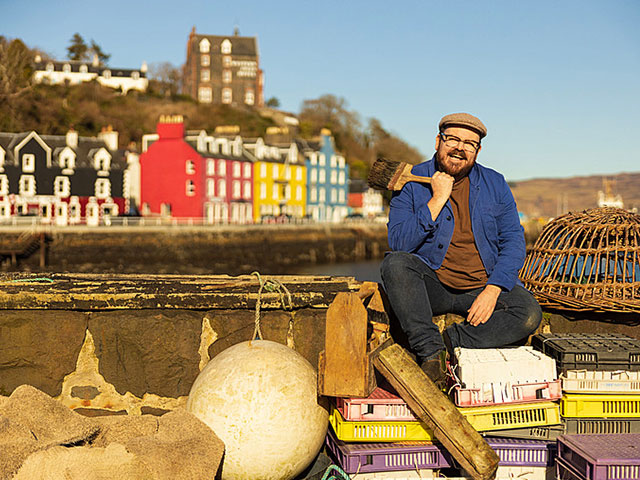
Designing the Hebrides: Banjo Beale’s new feel-good TV show
Having won both Interior Design Masters 2022 and the hearts of the British public, Banjo Beale is fronting a new TV show, Designing the Hebrides. It offers the viewer an insight into his life in Tobermory on the Isle of Mull, Scotland. Good Homes sits down with the loveliest man in interiors for a chat about the six-episode series, airing from 12 April 2023 on BBC Scotland, BBC Two and BBC iPlayer…
Island life
The Isle of Mull – the second largest island of the Inner Hebrides, off the west coast of Scotland – has been home to Banjo for over eight years with his husband Rohan, a cheesemaker, who often helps out on the show. But it’s perhaps not an ideal place to launch an interior design business? Especially when he has the world at his feet after winning Interior Design Masters.
‘I think it’s just such a special place,’ says Banjo. ‘I live in Tobermory, which I don’t know if you ever saw watched Balamory [the children’s TV show], but it’s the most colourful town in Scotland. But all the houses really are quite greyish inside. And I thought, it’s a bit crazy to start my business here, but I can do it. And the locals, they’re all my mates. Even in the show, they’re my mates.’
But bringing an interior design show to the Inner Hebrides was not without its challenges: ‘Number one, logistically, we’re on an island in the middle of nowhere. And we don’t have shops that we can run to, so you have to be really organised and resourceful. And I’m not organised. We have to make do with what we’ve got or improvise. A lot of it was using what I could get my hands on for free and using local people, craftsmen, and artisans.’
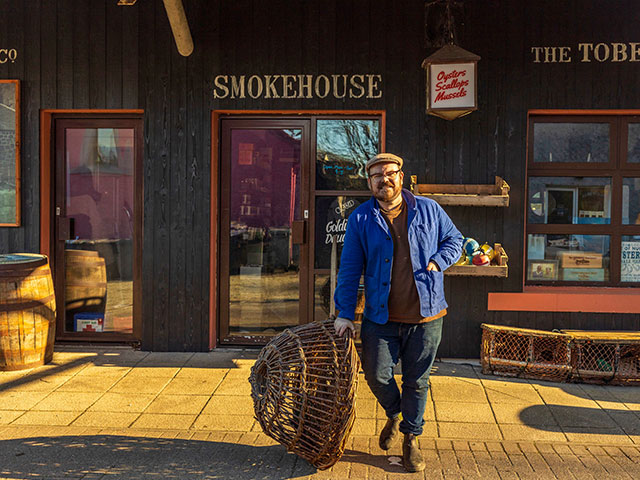
Banjo Beale in Designing The Hebrides. Photo: DSP / BBC / Alex Baxter
Improvisation was key
‘I turned cowbells into light pendants at a farm because they had no money. Also, some of the spaces are inaccessible, I had to take a boat, full of stuff out to a lighthouse we were designing, and I had to walk two hours to one space. On an island logistics are a big part of it.
‘With only a couple of trips to mainland, Banjo found most of what he needed on the island for all his spaces. ‘It’s amazing, really what people have in their front rooms or in their backyards. It’s proof really, that if I can do that living on an island, we can all probably do that a little bit more.
‘It doesn’t matter whether you’re living in London or the Hebrides, I think we can just decide to actually make a conscious effort not to run out to these big stores and buy flat things. ‘Because part of the adventure is just getting the free stuff, isn’t it? I love going and meeting the person that I’m getting it off and going into their living room and you’ve got a story then immediately where it’s from.
‘The biggest disaster I think was when a hurricane hit when we were filming the bothy episode on Designing the Hebrides. The bothy is a two-hour walk from the nearest road. It’s on the edge of the Atlantic Ocean. They usually use the shelters for trackers or fishermen, but this bothy was getting made over in two days, ready for guests to check into. Then the hurricane hit, and there was just water flowing in through the roof. That was a massive challenge!’
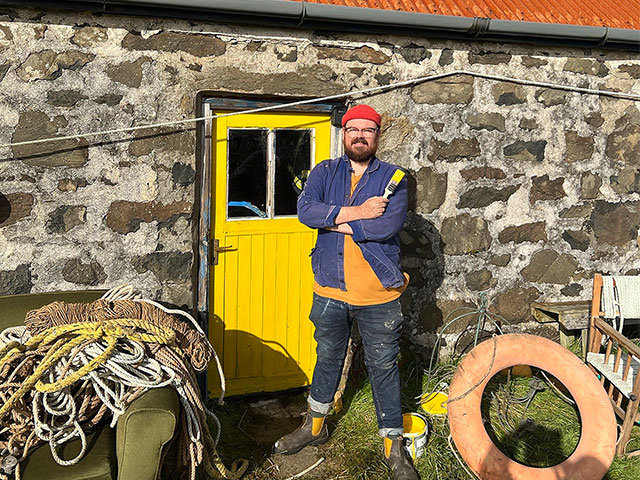
Banjo outside the Bothy on Ulva. Photo: DSP / BBC Scotland / BBC Two
Where it all started
So how exactly, did Banjo get into interior design?
‘Every Sunday, I used to rearrange my mum’s living room. I was around five years old and I would move it all around, and then at the end of the day, I’d have to change it back. And then I do it all over again the next weekend. I’d be so tired I’d just run myself a hot bath and pour myself a glass of juice in wine glass!
‘I grew up on a racetrack in the outback in Australia. Nobody really knew interior design was a career option. Then when I moved to the Isle of Mull from Australia, I watched Interior Design Masters. And I thought I should do that…’
The rest is history, but what was it really like being on the show? And how scary is Michelle Ogundehin when it comes to judgment time?
‘Well, at the time, it was the most terrifying thing in the entire world. But I think that’s for all of us because it means so much to us. And genuinely, you know, that Michelle just wants you to do the best. And she knows our potential. So, it’s her job to make it uncomfortable and for us to stretch ourselves.
‘She has such a command. And she is this huge figure that we’re trying to impress. And we want to impress her, and we’re scared of her because we don’t want to fail because it means so much. But ultimately, she’s like a little teddy bear. She’s so lovely. And you can feel it, when you’re in the room with her, she really takes it seriously because she knows that it’s changing all our lives.’
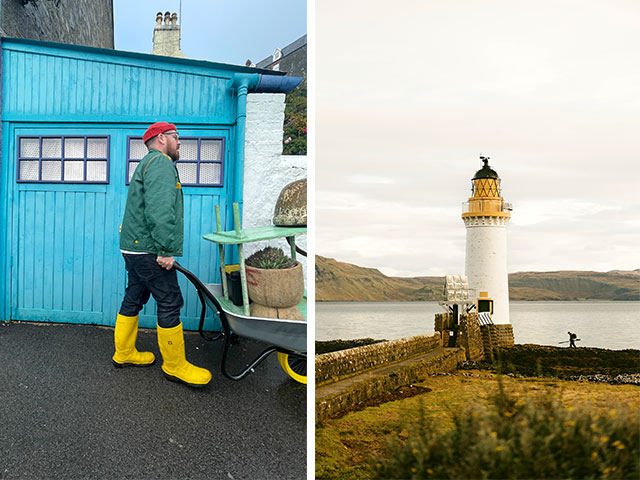
Left: Banjo Beale on Designing the Hebrides. Right. Rubha nan Gall lighthouse, north of Tobermory, is one of Banjo’s projects. Photos: DSP/ BBC Scotland / BBC Two
Becoming a judge
Following winning Interior Design Masters, Banjo got to travel all over Scotland judging Scotland’s Home of the Year, where he ‘travelled around Scotland for a month snooping through people’s homes from Orkney down to the borders. It was a dream job being a professional snoop.’
But what was it like to be on the side of the judging panel? ‘I thought it would be really hard because I have empathy for anyone that throws themselves open to judging. But when that camera rolls and then you see someone’s house, you have a visceral reaction, good or bad and there’s no hiding that! If I tried to lie, I’m wearing it on my face anyway. It’s a very lovely show, and all the houses are quite beautiful. But I’m not afraid to give my opinion on it.’
Sustaining local craft
And if that wasn’t keeping him busy enough, Banjo also runs a café and a shop on island and finds it the perfect way to immerse himself in the local community.
‘My husband is a cheese maker and distiller and that’s on that final episode of the show, actually. The farm (from where they lease the café and farm shop) is owned by an 87-year-old woman called Chris and ‘she’s my best bud, and on the final episode, I make her a gin bar and get a production line of grannies working for me, weaving chairs out of willow.
‘It’s special because I the first thing I did when I moved to the island, to be part of the community was join Woolley Wednesdays which is ‘stitch and bitch.’ And it was ten grannies teaching us how to knit and now they’re my good pals. For me, it’s about keeping a traditional life but putting, a modern twist on it. Which is how we can still make it relevant.’
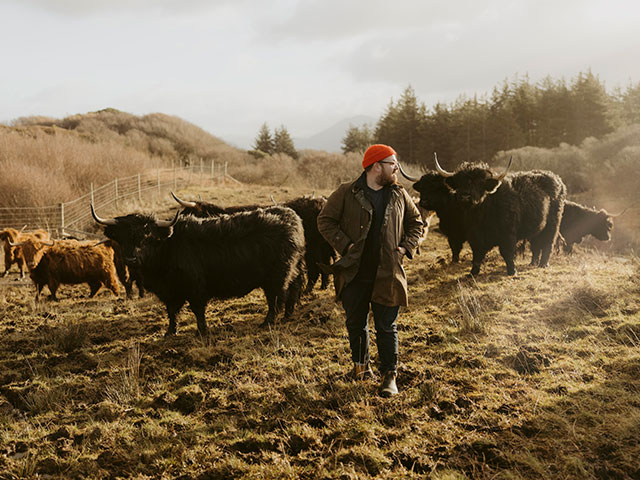
Designing the Hebrides. Photo: DSP / BBC / Alex Baxter
Slowing the pace of life
What is the pace of life like on island life?
‘Well, I would have said that the pace is slower, but I’m quite a chaotic person and anything I do tends to be a whirlwind, so I’m probably the wrong advertisement for slow living. But there is a definite pace that things move on an island, which means that you get to enjoy the smaller things. Tourism is a big thing on an island, and it just closes up in winter. It swells from around 10,000 people in summer, to 1000 or 500 people in winter.
‘So winter is when we do all our craft, when we do all our weaving, we knit, and we make all our preserves. We coorie, which is a Scottish word, meaning a kind of hunkering down, like a warm hug. We light the fire and just hibernate for five months. It’s bleak though. Because it’s super dark and, cold, but there’s something really magical about it.’
Finding inspiration
Is inspiration harder to come by, in those bleaker times?
‘No, I think I’m inspired by literature, by film, by my own imagination and by nature. When I was on Interior Design Masters, I used to create a character for all of my designs. Because it’s boring when you’re doing it for yourself, but on the island, the locals are the characters.
‘So, I’m designing for people, and you can’t write some of these people. When it’s the people and whatever materials I have around me, that’s enough to inspire me 100 times. I’m never going run out of ideas.’
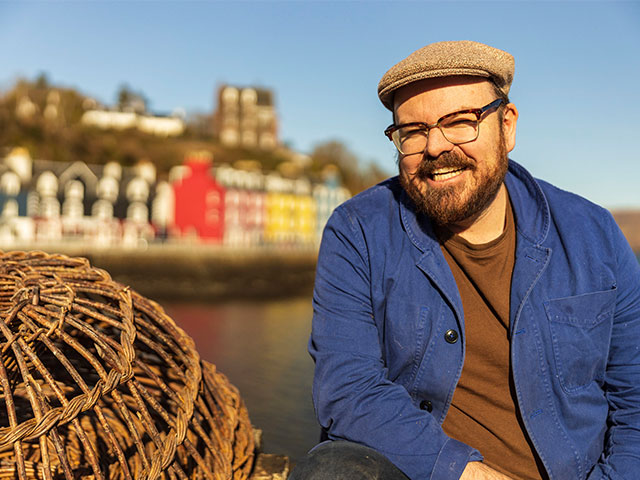
Designing the Hebrides. Photo: DSP / BBC / Alex Baxter
What’s next for Banjo?
There’s a book in the works, called Wild Isle Style, due out later in 2023.
‘The whole premise of the book is from the perspective of living on an island, embracing the materials that we have, using finite resources and only our own skills to bring them to life. So, it’s about taking that mindset into everything we do. Also on an island, you just have fun, there’s no pressure, and it’s not trying to be trendy. It’s just, it’s just a little bit of fun and tongue in cheek.’
And that feels like how you could describe Banjo, resourceful and fun and full of warmth and creativity. It’s hard not to feel so inspired that you want to up sticks and move to an island. He makes a strong case for it.
‘It’s about community and connection and stopping and being really grounded. And once you’re on [the Isle of Mull], you can’t get off. You’ve got to get a ferry and it’s a logistical challenge. When you’re there everything washes away and it’s just magic.’
MORE ON INTERIOR DESIGN MASTERS




